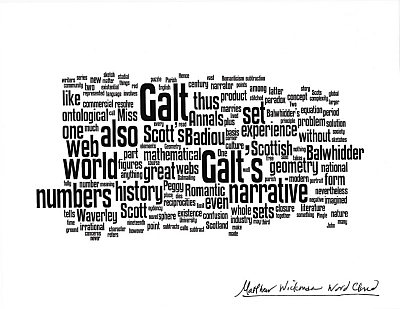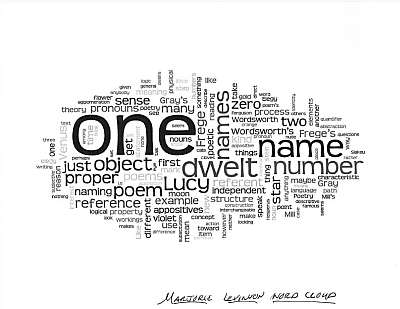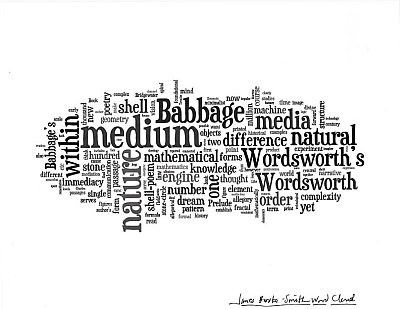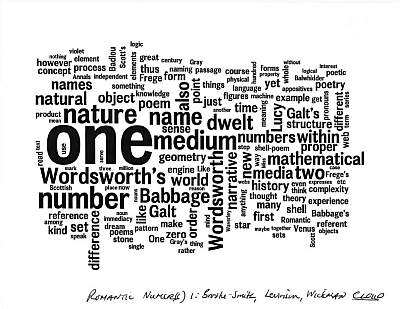I will take as an epigraph and perhaps an epitaph for this "set" of essays a question from Frege’s Foundations of Arithmetic, courtesy of Marjorie Levinson: “When we make a statement of number, what is that of which we assert something?”
Of romantic number: what is that of which our essayists have asserted something?
As a preliminary reflection on this first "set" of essays, and as an algorithmic operation performed on our essayists’ vocabularies, I offer here three word clouds, derived from each paper, followed by the mega- (or meta-)word cloud, the set of all sets (to invoke Wickman’s and Levinson’s turns to set theory, Bertrand Russell in particular): The Panel Word Cloud. (See Appendix for all word clouds.) As these word clouds suggest, Wickman, Levinson, and Brooke-Smith highlight some points of intersection and divergence in their consideration of romantic number.
Wickman and Brooke-Smith differently explore in their papers the relations between literature and geometry—viz. the status of geometry as a “national language” for the Scots (in Wickman), or the way Wordsworth (in Brooke-Smith) offers in his “dream vision of the survival of poetry and geometry, as represented by the allegorical figures of a shell and a stone” an “allegory of remediation.” So too these papers offer striking excavations (archaeologies, we might say) of conceptual preconditions and grids—as in the way geometry offers eighteenth-century thinkers a route out of the “ontological confusion” produced by “[a]lgebraic innovations,” “compensating visually for technical failures of calculation” (in Wickman’s account), or in the “media-less media theory” emergent in Brooke-Smith’s Wordsworth and Babbage. Drawing on formal language theory, Levinson frames a discussion of “number” (in Wordsworth, but by implication, not only) in terms of “name,” via the philosophy of reference. This is a new formalism, we might say, wholly other than the new formalism with which many romanticists might feel well acquainted. Brooke-Smith gives us a new medialism. Set theory makes its appearance in Wickman’s and Levinson’s inquiries—their work differently inflected by a genealogy running from Spinoza to the mathematician Georg Cantor to Deleuze and Badiou.
What is the set of romanticism and number? Of romantic numbers?
The word clouds suggest some provisional answers: the set of romantic number(s) includes Scottish geometry; Scott’s Badiou; many kinds of equations, problems, and operations; great webs; proper nouns; dream patterns; Wordsworth’s world; proper mathematical media. Numbers invoked include Zero, One, Two, a Million. (That these are not the same kind of number, that these invoke extremely different frames of reference, Levinson makes plain.) We encounter multitudes and singularities. An inquiry into romantic number has brought our essayists to consider number, measure, name, and medium. And so, in the spirit of their ranging inquiries, I will briefly turn to another lesson in number, measure, name and medium: offered by that great postromantic cohort, The Jackson Five—whose very name suggests a numbered singularity: The Jackson Five.
I direct you to their 1970 hit, “ABC,” viewable/audible on YouTube in several iterations—not least their appearance on Dick Clark. (Or see this for a fuzzier version of the performance, with the words helpfully subtitled over the video.)
Consider the lyrics of the chorus:
A-B-C . .Easy as 1-2-3Or simple as Do-Re-MiA-B-C1-2-35Baby you and me, girl!
In “ABC,” we encounter number as series—both finite and infinite series: ABC pointing to the finite series of the alphabet; 1-2-3 to the infinite set of real numbers; Do-Re-Mi to the notionally finite tones of the octave of a diatonic major scale. In the 4/4 pop meter of the song, the series become functionally equivalent sets: A-B-C = 1-2-3 = Do-Re-Mi = YOU AND ME. Items in a series, these sets are nonetheless bound and accounted for by the song’s rhythm, each series grouping working with (albeit syncopatedly) a 4/4 pattern, and each set consisting internally of three phonemes: ‘A-B-C = 1-2-3 = Do-Re-Mi = YOU AND ME’ These serial sets point, we might say, to an erotic and phonemic surplus governed by musical measure: Baby you and me, girl!
In the Jackson Five’s “ABC” we have an infectious pedagogy of accounting—in which series is converted to, and comes out of, structure: out of the alphabet, the set of real numbers, the solfège of the octave. Each series is meant to point to a single set, to a conceptual unity: the alphabet, real numbers, the scale, erotic union.
I invoke The Jackson Five’s “ABC” because their song raises and rephrases, in another medial key, the questions preoccupying these essays: how to get from series to totality? To the One? Is “romantic number” a route to new forms, new questions, new horizons? Or a recapitulation of old transcendentalizations?
Wickman’s Galt’s geometry is a wholly other thing than Brooke-Smith’s Wordsworth’s phantasmatic Euclidean geometry, yet “geometry” in both papers raises the question of reckoning with wholes and with complexity. In Brooke-Smith’s Wordsworth, for example, we find poetry and mathematics proposed as two routes to totality. Are these geometries merely figural? Do they perform actually mathematical and philosophical work? As Wickman notes, “Romantic-era numbers, even statistics and simple arithmetic, were effectively tropological constructs. Two plus two equaled a red, red rose.”
These papers invite us to reflect: is the turn to number, and to mathematics—both in these essays and more broadly in our discipline—a rebuke to recent modes of historicism, a triumph of a different kind of formalism, and/or a way of submitting the historical to the askesis of a much longer, perhaps species durée? And/or might these mathematical turns, both in the romantic period and our own, be themselves historicized in productive fashion?
Wickman directs us through Galt’s Annals and Badiou to the problem of the One—“the irreducible complexity of the world, prompting intellectuals to seek a new basis on which to order experience.” The collective work of these essays suggests to me that romanticists, like many scholars, are increasingly interested less in the production of knowledges than in the logic of emergent complexity. We see in Levinson’s and Brooke-Smith’s papers sharp meditations on measure and number, recurrence relations, the possible scaling up of the world. As Brooke-Smith writes, juxtaposing Wordsworth’s and Babbage’s projects, “Like Wordsworth’s dream vision, Babbage’s thought experiment contains at its center an image of fractal organization: the spiral of the shell-poem and the exfoliating algorithm of the difference engine both repeat the same pattern at different levels of scale and complexity.”
An awareness of emergent complexity (what Brooke-Smith calls “emergent patterns of organization”) prompts in some thinkers (romantic-era and now) a resistance to totalization and even to formalization: this is one way to understand Wickman’s productively resistant Galt. Wickman’s essay suggests that while Scott’s prose fictions might be converted into (and reliant upon) equations, Galt’s fiction eludes such calculability and formalization: “In Waverley, national culture is the effect of narrative closure, the product of a classical equation in which 1 + 1 = 1: Edward Waverley plus Rose—two characters—equals one estate; England plus Scotland—two nations—equals one Britain. Galt, however, complicates this equation by adding narrative elements that, in great webs of narrative reciprocities, never wholly resolve themselves into one.”
And so we are moved in these essays from Galt’s refusal of “one” (of a premature totalization) to Babbage’s difference engine to Levinson’s Gertrude Stein: Stein who wrote in Tender Buttons: “The difference is spreading” (313). And Oh, the difference engine to me!—and to you: baby you and me, girl.
Wickman offers us, via Badiou, a vision of Romanticism as the great evental subtraction: Scott’s narrators, and by extension lyrically sublime egos, Napoleonic colossi, and other romantic phenomena, emerge as the fabulously achieved product of a subtracting and abstracting operation. “[O]ne might say that the narrator of Waverley initiates a kind of event by subtracting himself from the chaos of experience (and from the ‘great web’ of national and picaresque tales) and thus converts a welter of aleatory occurrences and character types into a legible ordering of history, a grand narrative of the etiology of modern Britain.” In Wickman’s account we get a sense of the latent radical potential in Scott’s historical arithmetic—“despite Scott’s reputation for ideological conservatism.” Here Wickman’s account of Scott aligns intriguingly with Lukács’s and with more recent inquiries into Scott, notably James Chandler’s and Ian Duncan’s.
Wickman’s excursion into Badiou’s subtracting operations raises a number of questions, not least: Are subjects of history sums or remainders?
Levinson might be seen to answer this question, at least for Wordsworth’s “She Dwelt Among The Untrodden Ways.” As she notes in her intricate reading of the poem, conventional readings of “She Dwelt” often note how “it brings forth a one remaindered by the labor of ascesis.” Yet this one is also specifically produced, in her account: “one aris[es] from a trio of naming functions: namely, apposition, pronominal substitution, and the proper name.”
---Fair, as a star, when only one
Is shining in the sky!Only one.A One.One One.The one. But there’s a Tree, of many, one.5
After reading Levinson on one as itself perhaps a proper name, we might return to Wallace Stevens, with his own caressed and salvaged vocabularies, his ceaseless inquiry into “naming functions.” In “The Man on the Dump,” Stevens offers a degraded series, emptied postromantic contents:
The dump is fullOf images. Days pass like papers from a press.The bouquets come here in the papers. So the sun,And so the moon, both come, and the janitor’s poemsOf every day, the wrapper on the can of pears,5The cat in the paper-bag, the corset, the boxFrom Esthonia: the tiger chest, for tea . . .One grows to hate these things except on the dump. (184-5)
Following Levinson, we should take Stevens’s “One” not as a third-person impersonal pronoun but as a proper name—a number substantialized into a subject: “One grows to hate these things except on the dump.”
What is it to work on romanticism? Is it to be One on the Dump?—
Is it to sit among mattresses of the dead,Bottles, pots, shoes and grass and murmur aptest eve:Is it to hear the blatter of grackles and sayInvisible priest; is it to eject, to pullThe day to pieces and cry stanza my stone?5Where was it one first heard of the truth? The the. (186)
Before the one, the the; before the truth: the the; before the event, the definite article; before the noun, deixis; before the figure, the finger? The the.
Appendix: Word Clouds

Matthew Wickman |

Marjorie Levinson |

James Brooke-Smith |

All of Set 1 |

